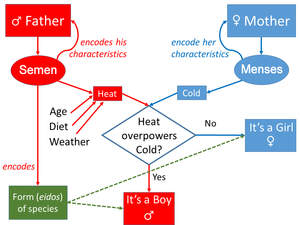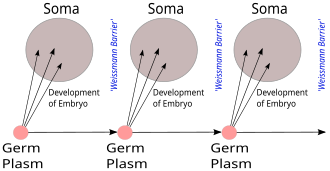History of genetics
| Part of a series on |
| Genetics |
|---|
 |
The history of genetics dates from the
In
The 1900 rediscovery of Mendel's work by
With the basic patterns of genetic inheritance established, many biologists turned to investigations of the physical nature of the gene. In the 1940s and early 1950s, experiments pointed to DNA as the portion of chromosomes (and perhaps other nucleoproteins) that held genes. A focus on new model organisms such as viruses and bacteria, along with the discovery of the double helical structure of DNA in 1953, marked the transition to the era of molecular genetics.
In the following years, chemists developed techniques for sequencing both nucleic acids and proteins, while many others worked out the relationship between these two forms of biological molecules and discovered the genetic code. The regulation of gene expression became a central issue in the 1960s; by the 1970s gene expression could be controlled and manipulated through genetic engineering. In the last decades of the 20th century, many biologists focused on large-scale genetics projects, such as sequencing entire genomes.
Pre-Mendel ideas on heredity
Ancient theories

The most influential early theories of heredity were that of
In the 9th century CE, the
Preformation theory

The preformation theory is a developmental biological theory, which was represented in antiquity by the Greek philosopher Anaxagoras. It reappeared in modern times in the 17th century and then prevailed until the 19th century. Another common term at that time was the theory of evolution, although "evolution" (in the sense of development as a pure growth process) had a completely different meaning than today. The preformists assumed that the entire organism was preformed in the sperm (animalkulism) or in the egg (ovism or ovulism) and only had to unfold and grow. This was contrasted by the theory of epigenesis, according to which the structures and organs of an organism only develop in the course of individual development (Ontogeny). Epigenesis had been the dominant opinion since antiquity and into the 17th century, but was then replaced by preformist ideas. Since the 19th century epigenesis was again able to establish itself as a view valid to this day.[7][8]
Plant systematics and hybridisation
In the 18th century, with increased knowledge of plant and animal diversity and the accompanying increased focus on
Plant breeders were also developing an array of stable
Mendel

Between 1856 and 1865, Gregor Mendel conducted breeding experiments using the pea plant Pisum sativum and traced the inheritance patterns of certain traits. Through these experiments, Mendel saw that the genotypes and phenotypes of the progeny were predictable and that some traits were dominant over others.[12] These patterns of Mendelian inheritance demonstrated the usefulness of applying statistics to inheritance. They also contradicted 19th-century theories of blending inheritance, showing, rather, that genes remain discrete through multiple generations of hybridisation.[13]
From his statistical analysis, Mendel defined a concept that he described as a character (which in his mind holds also for "determinant of that character"). In only one sentence of his historical paper, he used the term "factors" to designate the "material creating" the character: " So far as experience goes, we find it in every case confirmed that constant progeny can only be formed when the egg cells and the fertilising pollen are off like the character so that both are provided with the material for creating quite similar individuals, as is the case with the normal fertilisation of pure species. We must, therefore, regard it as certain that exactly similar factors must be at work also in the production of the constant forms in the hybrid plants."(Mendel, 1866).

Mendel's work was published in 1866 as "Versuche über Pflanzen-Hybriden" (
Post-Mendel, pre-rediscovery
Pangenesis
Mendel's work was published in a relatively obscure
Germ plasm

In 1883 August Weismann conducted experiments involving breeding mice whose tails had been surgically removed. His results — that surgically removing a mouse's tail had no effect on the tail of its offspring — challenged the theories of pangenesis and Lamarckism, which held that changes to an organism during its lifetime could be inherited by its descendants. Weismann proposed the germ plasm theory of inheritance, which held that hereditary information was carried only in sperm and egg cells.[18]
Rediscovery of Mendel
Hugo de Vries wondered what the nature of germ plasm might be, and in particular he wondered whether or not germ plasm was mixed like paint or whether the information was carried in discrete packets that remained unbroken. In the 1890s he was conducting breeding experiments with a variety of plant species and in 1897 he published a paper on his results that stated that each inherited trait was governed by two discrete particles of information, one from each parent, and that these particles were passed along intact to the next generation. In 1900 he was preparing another paper on his further results when he was shown a copy of Mendel's 1866 paper by a friend who thought it might be relevant to de Vries's work. He went ahead and published his 1900 paper without mentioning Mendel's priority. Later that same year another botanist, Carl Correns, who had been conducting hybridisation experiments with maize and peas, was searching the literature for related experiments prior to publishing his own results when he came across Mendel's paper, which had results similar to his own. Correns accused de Vries of appropriating terminology from Mendel's paper without crediting him or recognising his priority. At the same time another botanist, Erich von Tschermak was experimenting with pea breeding and producing results like Mendel's. He too discovered Mendel's paper while searching the literature for relevant work. In a subsequent paper de Vries praised Mendel and acknowledged that he had only extended his earlier work.[18]
Emergence of molecular genetics
After the rediscovery of Mendel's work there was a feud between
In 1910,
A series of subsequent discoveries (e.g.
In 1947 Salvador Luria discovered the reactivation of irradiated phage[25] leading to many further studies on the fundamental processes of repair of DNA damage (for review of early studies, see [26]). In 1958 Meselson and Stahl demonstrated that DNA replicates semiconservatively, leading to the understanding that each of the individual strands in double-stranded DNA serves as a template for new strand synthesis.[27] In 1960 Jacob and collaborators discovered the operon which consists of a sequence of genes whose expression is coordinated by operator DNA.[28] In the period 1961 – 1967, through work in several different labs, the nature of the genetic code was determined (e.g. [29]).
In 1972,
that neither DNA nor protein would be required in such a primitive system as that of a very early stage of the earth if RNA could serve both as a catalyst and as genetic information storage processor.The modern study of genetics at the level of DNA is known as molecular genetics and the synthesis of molecular genetics with traditional Darwinian evolution is known as the modern evolutionary synthesis.
See also
- List of sequenced eukaryotic genomes
- History of molecular biology
- History of RNA Biology
- History of evolutionary thought
- One gene-one enzyme hypothesis
- Phage group
References
- ^ a b Leroi, Armand Marie (2010). Föllinger, S. (ed.). Function and Constraint in Aristotle and Evolutionary Theory. Franz Steiner Verlag. pp. 215–221.
{{cite book}}:|work=ignored (help) - ^ Mayr, The Growth of Biological Thought, pp 635–640
- ^ Yapijakis C. (2017) Ancestral Concepts of Human Genetics and Molecular Medicine in Epicurean Philosophy. In: Petermann H., Harper P., Doetz S. (eds) History of Human Genetics. Springer, Cham
- JSTOR 984852.
- ISBN 978-0-8160-4887-8.
- Ibn Tibon, p.375: ונראה כזה בענין הטבעי, כי כמה יש מבני האדם שאינו דומה לאב כלל אך הוא דומה לאבי אביו ואין ספק כי הטבע ההוא והדמיון ההוא היה צפון באב ואף על פי שלא נראה להרגשה
- ISBN 3-10-035601-2
- ^ Ilse Jahn, Rolf Löther, Konrad Senglaub (Editor): Geschichte der Biologie. Theorien, Methoden, Institutionen, Kurzbiographien. 2nd edition. VEB Fischer, Jena 1985
- ^ Mayr, The Growth of Biological Thought, pp 640–649
- ^ Mayr, The Growth of Biological Thought, pp 649–651
- ^ For example, Explanatory Notes, Gartons Seed Catalogue for Spring 1901
- ISBN 978-1-319-29714-5.
- ^ Mukherjee, Siddartha (2016) The Gene: An intimate history Chapter 4.
- ISSN 1059-1028. Retrieved 11 November 2019.
- ^ Darwin, C. R. (1871). Pangenesis. Nature. A Weekly Illustrated Journal of Science 3 (27 April): 502–503.
- PMID 4908353.
- ISBN 978-0-801-88140-4.
- ^ a b Mukherjee, Siddartha (2016) The Gene:An intimate history Chapter 5.
- ^ HERSHEY AD, CHASE M. Independent functions of viral protein and nucleic acid in growth of bacteriophage. J Gen Physiol. 1952 May;36(1):39-56. doi: 10.1085/jgp.36.1.39. PMID: 12981234; PMCID: PMC2147348
- ^ Beadle GW, Tatum EL. Genetic Control of Biochemical Reactions in Neurospora. Proc Natl Acad Sci U S A. 1941 Nov 15;27(11):499-506. doi: 10.1073/pnas.27.11.499. PMID: 16588492; PMCID: PMC1078370
- PMID 17567988.
- PMID 8294854.
- ISBN 978-1-319-29714-5.
- ^ WATSON JD, CRICK FH. Molecular structure of nucleic acids; a structure for deoxyribose nucleic acid. Nature. 1953 Apr 25;171(4356):737-8. doi: 10.1038/171737a0. PMID: 13054692
- ^ Luria SE. Reactivation of Irradiated Bacteriophage by Transfer of Self-Reproducing Units. Proc Natl Acad Sci U S A. 1947 Sep;33(9):253-64. doi: 10.1073/pnas.33.9.253. PMID: 16588748; PMCID: PMC1079044
- ^ Bernstein C. Deoxyribonucleic acid repair in bacteriophage. Microbiol Rev. 1981 Mar;45(1):72-98. doi: 10.1128/mr.45.1.72-98.1981. PMID: 6261109; PMCID: PMC281499
- ^ Meselson M, Stahl FW. THE REPLICATION OF DNA IN ESCHERICHIA COLI. Proc Natl Acad Sci U S A. 1958 Jul 15;44(7):671-82. doi: 10.1073/pnas.44.7.671. PMID: 16590258; PMCID: PMC528642
- ^ Jacob F, Perrin D, Sánchez C, Monod J, Edelstein S. The operon: a group of genes with expression coordinated by an operator. C.R.Acad. Sci. Paris 250 (1960) 1727-1729. C R Biol. 2005 Jun;328(6):514-20. English, French. doi: 10.1016/j.crvi.2005.04.005. PMID: 15999435
- ^ CRICK FH, BARNETT L, BRENNER S, WATTS-TOBIN RJ. General nature of the genetic code for proteins. Nature. 1961 Dec 30;192:1227-32. doi: 10.1038/1921227a0. PMID: 13882203
- S2CID 4153893.
- S2CID 4420674.
- S2CID 36463252.
Further reading
- ISBN 0-87969-675-3
External links
This section's use of external links may not follow Wikipedia's policies or guidelines. (January 2023) |
- Olby's "Mendel, Mendelism, and Genetics," at MendelWeb
- ""Experiments in Plant Hybridization" (1866), by Johann Gregor Mendel," by A. Andrei at the Embryo Project Encyclopedia
- http://www.accessexcellence.org/AE/AEPC/WWC/1994/geneticstln.html
- http://www.sysbioeng.com/index/cta94-11s.jpg
- http://www.esp.org/books/sturt/history/
- http://cogweb.ucla.edu/ep/DNA_history.html
- http://news.bbc.co.uk/1/hi/in_depth/sci_tech/2000/human_genome/749026.stm
- https://web.archive.org/web/20120323085256/http://www.hchs.hunter.cuny.edu/wiki/index.php?title=Modern_Science&printable=yes
- http://jem.rupress.org/content/79/2/137.full.pdf
- http://www.nature.com/physics/looking-back/crick/Crick_Watson.pdf
- Todd, AR (1954). "Chemical Structure of the Nucleic Acids". Proc. Natl. Acad. Sci. U.S.A. 40 (8): 748–55. PMID 16589553.
- http://www.genomenewsnetwork.org/resources/timeline/1960_mRNA.php
- https://web.archive.org/web/20120403041525/http://www.molecularstation.com/molecular-biology-images/data/503/MRNA-structure.png
- http://www.genomenewsnetwork.org/resources/timeline/1973_Boyer.php
- http://www.genetics.org/cgi/content/full/180/2/709
- PMID 271968.
- S2CID 4229883.
- Cech, T. R.; Bass, B. L. (1986). "Biological Catalysis by RNA". Annual Review of Biochemistry. 55: 599–629. PMID 2427016.
- http://www.cnn.com/TECH/9702/24/cloning.explainer/index.html
- http://www.genome.gov/11006943
